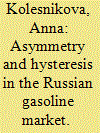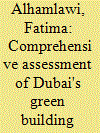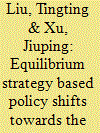|
|
|
Sort Order |
|
|
|
Items / Page
|
|
|
|
|
|
|
| Srl | Item |
| 1 |
ID:
180176


|
|
|
|
|
| Summary/Abstract |
Can community energy help to overcome inequalities in who benefits from low-carbon technologies? Research has shown that the distribution of low-carbon technology subsidies and their associated benefits can be highly uneven across socioeconomic groups, revealing a persistent inequality issue. Yet this research has tended to focus almost exclusively on adoption of technologies at the household-level, with limited insights into whether and how this distribution might differ in the case of community energy. To address this, this paper quantitatively investigates the distribution of payments to household- and community-level energy systems across socioeconomic groups in Scotland under the UK government feed-in-tariff. Analysis is conducted on a novel dataset of 26,218 household and community wind and solar installations across 6,976 micro-level data-zones using a combination of distributional analysis and random effects within-between regression. It finds that feed-in-tariff payments for household-level wind and solar PV systems have heavily benefitted more affluent socioeconomic groups, while payments to community energy projects have flowed more consistently into areas of higher deprivation, particularly in the case of community solar. These findings suggest that community energy has been successful in bringing the benefits of low-carbon technologies to areas of lower income and higher deprivation, with important lessons for policymakers concerned with a just transition going forward.
|
|
|
|
|
|
|
|
|
|
|
|
|
|
|
|
| 2 |
ID:
180184


|
|
|
|
|
| Summary/Abstract |
Biofuels in Ecuador were born with the purpose of achieving an effective substitution of imports of petroleum derivatives. The objective of this research is to analyze the impact that biofuel production has on water, food, and energy, and its contribution to reducing the growing dependence on fossil fuels in the transportation sector in Ecuador. The analysis focuses on ethanol produced from sugar cane, which is used to produce Ecopaís gasoline. The methodology is composed of three parts. For the first part, Geographic Information Systems were used; for the second, the FAO Penman-Monteith method; and, finally, in the third, the energy consumption was obtained through secondary information. As a result, taking the year 2019 as a reference, ethanol became the ninth product with the largest amount of land suitable for agriculture, and the seventh with the most irrigated areas in a country that suffers from malnutrition. Countries with a tropical climate and highly dependent on imports of petroleum derivatives are tempted to implement policies to promote biofuels. However, due to the risks that this renewable fuel represents on food security, other options for reducing its energy dependence should be exhausted.
|
|
|
|
|
|
|
|
|
|
|
|
|
|
|
|
| 3 |
ID:
180163


|
|
|
|
|
| Summary/Abstract |
Using monthly data of 79 Russian regions from 2003 to 2017, we study the long-run relationship of the retail gasoline prices with the crude oil price and the nominal exchange rate. We find that models that were successfully applied to deal with asymmetries in other countries are not suitable for Russia without taking structural breaks into account. Once breaks are allowed, we find that there is no asymmetry in the long-run elasticities between the gasoline prices and the crude oil price, and no significant hysteresis. However, there is an asymmetric relation between the gasoline price and the exchange rate that has decreased over time. These results also hold after several robustness checks. The evidence reported in this work shows that the effects of the exchange rate on gasoline prices are much more difficult to control than the oil price, and they require a larger set of policy measures: the recent development of a plan to decrease the importance of hydrocarbons exports by producing clean hydrogen using electrolysis and pyrolysis and the potential future export of electricity generated using nuclear power and onshore wind farms may help to diversify the local economy and to shield it from new sanctions.
|
|
|
|
|
|
|
|
|
|
|
|
|
|
|
|
| 4 |
ID:
180174


|
|
|
|
|
| Summary/Abstract |
This article discusses how the existing regulatory, informative, and financial instruments for the renovation of existing building stock in Spain could be combined to produce a national ‘Building Renovation Passport’, that is expected to be introduced by the European Commission in 2023. This work also argues in favour of integrating the existing tools for the conservation of heritage buildings in the Passport, and surveys current mechanisms used as ‘interfaces’ between heritage conservation and broader, building stock conservation-related instruments that are already in use and could be helpful in the aforementioned integration. The latter would allow all stakeholders to identify those improvement opportunities that are compatible with heritage protection and plan for the staged conservation, restoration, and adaptation of any heritage building, reducing transaction costs and enhancing conservation by reducing the use of existing exemption clauses from compliance with technical regulations. The division of competences between government levels, a risk of excessive technical complexity, and the need to take the urban scale into consideration will emerge as the main challenges for an initiative that could be adapted to the legal framework of other Member States.
|
|
|
|
|
|
|
|
|
|
|
|
|
|
|
|
| 5 |
ID:
180186


|
|
|
|
|
| Summary/Abstract |
This paper uses the carbon emissions trading pilot study of 2013 as a quasi-natural experiment, combined with panel data of 30 provinces and cities in China during 2000–2017, and applies the difference-in-difference (DID) model to investigate the specific impact and mechanism of the carbon emissions trading scheme (ETS) on energy efficiency. The results, which and passed a series of robustness tests, showed that the carbon ETS can significantly improve single-factor energy efficiency and total-factor energy efficiency. The effect mechanism test showed that the carbon ETS can improve energy efficiency by promoting technological innovation of enterprises, and that the marketization level enhanced the carbon ETS's promotion of energy efficiency. Furthermore, this study measures the energy rebound effect at the macro level in China. The results showed that the average energy rebound effect in China is 79.94%. Once the carbon emission trading pilot work was officially launched, the energy rebound effect of the pilot provinces was significantly higher than that of the non-pilot provinces, and the energy conservation effect of the carbon ETS did not function as expected. The research conclusions of this paper provide empirical evidence and policy inspiration for China to improve energy efficiency and accelerate the process of energy conservation.
|
|
|
|
|
|
|
|
|
|
|
|
|
|
|
|
| 6 |
ID:
180185


|
|
|
|
|
| Summary/Abstract |
In 2021, Germany launched a national emissions trading system (ETS) in its road transport and housing sectors that increases the cost burden of consumers of fossil fuels, the major source of carbon dioxide (CO2) emissions. A promising approach to secure public acceptance for such a carbon pricing would be to entirely reallocate the resulting “carbon” revenues to consumers. This article discusses three alternatives that were discussed in the political arena prior to the introduction of the national carbon pricing: a) a per-capita reallocation to private households, b) the reduction of electricity prices by, e.g., decreasing the electricity tax, as well as c) targeted financial aid for vulnerable consumers, such as increasing housing benefits. To estimate both the revenues originating from carbon pricing and the resulting emission savings, we employ a partial equilibrium approach that is based on price elasticity estimates on individual fossil fuel consumption from the empirical literature. Most effective with respect to alleviating the burden of poor households would be increasing housing benefits. While this measure would not require large monetary resources, we argue that the remaining revenues should be preferably employed to reduce Germany's electricity tax, which becomes more and more obsolete given the steadily increasing amount of electricity generated by renewable energy technologies.
|
|
|
|
|
|
|
|
|
|
|
|
|
|
|
|
| 7 |
ID:
180157


|
|
|
|
|
| Summary/Abstract |
In line with global trends towards energy efficiency, Dubai's Government introduced Al Sa'fat Green Building Rating System (GBRS) to reduce the energy intensity of its building sector. This study presents the first comprehensive evaluation of Al Sa'fat with emphasis on building energy performance, shedding light on its effectiveness, limitations, and techno-economic potential. Following a comparison of Al Sa'fat to international and regional GBRSs, a detailed energy-efficiency analysis is conducted using building performance simulations applied to local residential and commercial building archetypes. The benefits of adopting Al Sa'fat at the urban scale are then estimated using a macro techno-economic analysis. Results confirm the potential of Al Sa'fat in curbing current consumption patterns with energy savings ranging from 22% for hotel buildings to 63% for single-family villas. The anticipated monetary savings from adopting Al Sa'fat in Dubai are equally significant and could exceed USD 100 Billion over the next 25 years. Finally, recommendations are made to overcome critical limitations of Al Sa'fat, including the minimal emphasis on water efficiency measures and limited differentiation between its current certification levels (i.e., bronze, silver, gold, and platinum), which could discourage building owners and developers from pursuing high certification levels.
|
|
|
|
|
|
|
|
|
|
|
|
|
|
|
|
| 8 |
ID:
180162


|
|
|
|
|
| Summary/Abstract |
Natural gas plays an important role in the global energy system. Thus, optimizing trade in natural gas is a key concern for many countries. This study investigates the value of expanding the Gulf Cooperation Council's (GCC) natural gas grid. We consider the documented successes and failures of the regional gas trade in Europe and Asia and weigh them against a GCC case study. The case study uses a partial equilibrium model of energy production, trade and demand calibrated to 2018 conditions to assess regional pipeline gas trade opportunities. The model incorporates parameters that are relevant to energy policy issues, including fuel allocation and energy price reforms. We also incorporate the regional liquified natural gas (LNG) trade strategy of Qatar, a regional and global leader in LNG production and exports. We find that pipeline gas trade cooperation in the GCC can contribute up to $3.1 billion to the regional economy by reducing transportation costs. More accessible gas offers a substitute for liquid fuel consumption and can offset the opportunity costs of using domestic oil to meet domestic energy demands. We also investigate the influence of an integrated gas market and price reforms on the power trade along the GCC interconnector.
|
|
|
|
|
|
|
|
|
|
|
|
|
|
|
|
| 9 |
ID:
180183


|
|
|
|
|
| Summary/Abstract |
A central issue that is discussed in climate policy is the fear of owners of stocks of fossil hydrocarbon deposits that high CO2 taxes and bans on the combustion use of hydrocarbons will turn their stocks into stranded assets. They might react by extracting and selling their reserves today: a rush to burn results. We show how the stranded-asset problem could be avoided or strongly moderated. We analyze a simple intertemporal equilibrium with a given stock of fossil hydrocarbons. The key variable for a climate-neutral solution to the rush-to-burn problem is to maintain existing and generate new markets for climate-neutral products from fossil hydrocarbons in the future. We give examples of such products. In this framework subsidies for such products (or for their innovation) also reduce the rush-to-burn problem. In contrast, the creation of substitutes for fossil hydrocarbon-based climate-neutral products, or subsidies for such products reduce the market for products made from fossil hydrocarbons. This aggravates the stranded-assets problem and thus has a climate-damaging effect.
|
|
|
|
|
|
|
|
|
|
|
|
|
|
|
|
| 10 |
ID:
180171


|
|
|
|
|
| Summary/Abstract |
Energy audits help to increase energy efficiency in industry and have proven effective in many studies. Additional implementation support programmes providing financial incentives have been developed to not only support audits but also to overcome financial barriers to energy efficiency investments. Because the different types of programmes coexist, we argue that a precise analysis of their effects must explicitly model them together, demonstrating non-trivial direct and indirect effects of both audits and financial programmes on the adoption of energy efficiency measures. We corroborate the presence of these direct and indirect effects with data on German firms, all of which have participated in an energy audit programme and some of which have additionally received financial implementation support. Audits not only affect the adoption of energy efficiency measures directly, they also increase the likelihood of receiving financial implementation support, which in turn increases the adoption rate. Furthermore, our findings highlight that consultancy during implementation is an important factor for adoption. Accordingly, additional supporting policies should be considered in future energy audits, for example to ensure assistance during implementation.
|
|
|
|
|
|
|
|
|
|
|
|
|
|
|
|
| 11 |
ID:
180169


|
|
|
|
|
| Summary/Abstract |
Energy sufficiency is one of the three energy sustainability strategies, next to energy efficiency and renewable energies. We analyse to what extent European governments follow this strategy, by conducting a systematic document analysis of all available European National Energy and Climate Plans (NECPs) and Long-Term Strategies (LTSs). We collect and categorise a total of 230 sufficiency-related policy measures, finding large differences between countries. We find most sufficiency policies in the transport sector, when classifying also modal shift policies to change the service quality of transport as sufficiency policies. Types of sufficiency policy instruments vary considerably from sector to sector, for instance the focus on financial incentives and fiscal instruments in the mobility sector, information in the building sector, and financial incentive/tax instruments in cross-sectoral application. Regulatory instruments currently play a minor role for sufficiency policy in the national energy and climate plans of EU member states. Similar to energy efficiency in recent decades, sufficiency still largely referred to as micro-level individual behaviour change or necessary exogenous trends that will need to take place. It is not treated yet as a genuine field of policy action to provide the necessary framework for enabling societal change.
|
|
|
|
|
|
|
|
|
|
|
|
|
|
|
|
| 12 |
ID:
180164


|
|
|
|
|
| Summary/Abstract |
As part of China's power industry reforms, developing appropriate market designs for the inclusion of renewable energy in the electricity spot market has been an ongoing challenge. This paper examined the effects of different market rules on wind power producer behavior to identify the policy implications for a renewable-friendly spot market, for which a market equilibrium model was developed to assess power transactions in the day-ahead and balancing markets, with the upper level being wind power producers seeking the best profits, and the lower level being the market clearing process to minimize generation costs. A case study is given, in which different scenarios are explored to assess the effects of bidding regulations and imbalance pricing mechanisms and to simulate the rising wind penetration in power systems. It was found that in the region modeled: more relaxed bidding regulations could provide wind producers incentives by allowing more profitable strategies; the imbalance pricing settings influence market results and producer revenues; and lower spot prices and power generation costs occur if a larger wind share was fed into the power system and could result in a unit revenue decline. Therefore, new policy directions are needed for the development of China's renewable-friendly electricity markets.
|
|
|
|
|
|
|
|
|
|
|
|
|
|
|
|
| 13 |
ID:
180188


|
|
|
|
|
| Summary/Abstract |
In modern developed economies, one of the primary objectives is to manage the transition from polluting to cleaner technologies as efficiently as possible. By now, in the current empirical literature, one can identify technological spillovers from environmental innovations as a major driver of this process. Specific energy policy aspects connected with industry behaviour have yet to be explored. The aim of this paper is to investigate energy efficiency via environmental innovation and the resulting degree of resilience and adaptation of both developed and developing countries. The work applies the non-parametric DEA (Data Envelopment Analysis) framework and Tobit analysis. For this scope, it is built a panel dataset made of some 5000 observations based on energy policy and sustainable development variables for 136 OECD and non-OECD countries. The results show that knowledge spillovers from environmental innovations reduce inefficiency and therefore strengthen the resilience of economies that decide and manage to invest adequately in the transition to more sustainable technologies. Besides, OECD countries improve their energy efficiency scores over time, whilst non-OECD countries do not. This implies that sustainable technologies transition is made more efficient by environmental innovation but the process is fostered by disposing of a resilient economic system – hence, vulnerability can affect the transition. These hypotheses lead to important economic, social and environmental implications for energy policy modelling.
|
|
|
|
|
|
|
|
|
|
|
|
|
|
|
|
| 14 |
ID:
180155


|
|
|
| 15 |
ID:
180158


|
|
|
|
|
| Summary/Abstract |
Highway fast-charging (HFC) stations for electric vehicles (EVs) are necessary to address range anxiety concerns and thus to support economy-wide decarbonization goals. The characteristics of HFC electricity demand – its relative inflexibility, high power requirements, and spatial concentration – have the potential to adversely impact grid operations as HFC infrastructure expands. Here, we investigate the impacts of scaled-up HFC infrastructure using an operations model of the 2033 Texas power grid with uniquely high spatial and temporal resolution. In the reference EV penetration case corresponding to 3 million passenger EVs on the road, we find that grid-HFC interactions increase system annual operational costs by 8%, or nearly $2 per MWh of load served. Greater impacts are observed for higher EV penetration cases. The high spatial resolution of the analysis reveals that the majority of increased costs can be attributed to transmission congestion on feeder lines serving a minority of HFC stations. Four-hour battery energy storage is shown to be more effective than demand flexibility as mitigation, due to the long duration of peak charging demand anticipated at HFC stations. Transmission network upgrades can also effectively mitigate grid-HFC interactions. Choosing the most effective mitigation strategy for each station requires a tailored approach.
|
|
|
|
|
|
|
|
|
|
|
|
|
|
|
|
| 16 |
ID:
180167


|
|
|
|
|
| Summary/Abstract |
This work analyzes the grid parity of distributed photovoltaic generation (DG-PV) in the province of San Juan-Argentina, proving that currently, the levelized cost of DG-PV is on average 20% higher than the tariff price for residential customers. In order to achieve the grid parity, the provincial government should implement incentive mechanisms such as the Net Billing proposed in the National Law 27.424 (2017). The impact of the Net Billing scheme proposed in such law, from the point of view of a typical residential user, and also compared with the impact of the Net Metering and Feed-in Tariff mechanisms are presented in this work. Results show that the Net Metering scheme could be the most profitable or economically beneficial for PV-owners, but it could have some negative impact on the incomes of utilities. Besides, investment decisions in renewable distributed generation are significantly affected by technological costs, national financial conditions, and tariffs. This analysis also suggests that taxes included in the tariff structure are an important aspect to take into account for implementing incentive mechanisms. Finally, some energy policies are recommended to guarantee the profitability of DG-PV systems and to assist the government in making decisions to promote these systems.
|
|
|
|
|
|
|
|
|
|
|
|
|
|
|
|
| 17 |
ID:
180175


|
|
|
|
|
| Summary/Abstract |
The process of residential energy retrofitting needs to be advanced, especially in the hot summer and cold winter (HSCW) zone of China. Good cooperation from homeowners is the key to the smooth project implementation. Some studies have identified four categories of information as important factors affecting homeowners' decision-making in retrofitting. Such information can improve homeowners' cooperation to some extent. This paper investigates the nature of this influence mechanism of retrofitting information, so as to stimulate homeowners' cooperation. The authors, first, explain how the direct relationship between information and homeowners' level of cooperation is validated. Second, under the mediation role of risk perception, we verify the indirect influence of such information. Third, we analyse the variation in the strength of the relationships between information and homeowners' cooperation under the influence of source credibility. It is concluded that providing information on retrofitting benefits and service is more effective for improving homeowners’ cooperation. The integrity of building quality information and the understandability, to the homeowners, of technology information need to be considered. Priority should be given to the sources of expert knowledge and published resources, because they are perceived by homeowners to be relatively credible. Policy suggestions are proposed based on the results.
|
|
|
|
|
|
|
|
|
|
|
|
|
|
|
|
| 18 |
ID:
180182


|
|
|
|
|
| Summary/Abstract |
Administrative and order-based environmental regulation policies have always been the main means of pollution control by the government. While, their effects are difficult to assess. The Chinese government implemented a desulfurization subsidy policy for on-grid tariffs, which was implemented in two phases (phase 1: 2004 to 2006; phase 2: since 2007). Considering the dynamic characteristics of the policy, this study adopted three empirical strategies, including difference-in-differences (DID) and pseudo DID method, to verify the causal relationship between the policy and SO2 reduction in China's coal-fired power plants. The results show that there is a clear causal relationship between the policy and SO2 emission reduction. Moreover, the dynamic effect of the desulfurization price subsidy policy has shown an increasing annual trend. The desulfurization price subsidy has effectively motivated enterprises to implement desulfurization facilities, meaning that the capacity for desulfurization and the associated operating costs have been significantly improved. In addition, heterogeneity shows that the desulfurization price subsidy policy performs better in higher marketization and underdeveloped regions. Thus, the Chinese government should strengthen the implementation of electricity price subsidies for desulfurization, and pay attention to the effect and duration of the policy in the process of implementation.
|
|
|
|
|
|
|
|
|
|
|
|
|
|
|
|
| 19 |
ID:
180165


|
|
|
|
|
| Summary/Abstract |
A fundamental policy question for distributed energy resources (DER) is whether they create system benefits shared by all utility customers in addition to being profitable for the installing customer. This question has received considerable attention in “value of DER” and net metering reform proceedings for behind-the-meter solar photovoltaics in recent years. Commercial customer-sited lithium-ion batteries with a primary use case of demand charge management are forecast to greatly increase in the coming decade due to falling storage costs, making comparison of their customer and system benefits a timely topic in DER valuation. We conduct an overview of the system benefits of standalone commercial customer-sited storage on United States’ electric tariffs and find system benefits will not be realized for many standalone commercial customer-sited storage installations in the absence of incentives for storage dispatch during the top 50–100 annual hours that drive grid infrastructure investment. Regulatory implementation of default peak pricing during a small subset of annual hours for customer-sited storage can realize additional system benefits and offer Pareto improvement. Additional transparency in regulatory estimates of these system benefits helps catalyze longer-term visions for increased competition at the retail level using DERs.
|
|
|
|
|
|
|
|
|
|
|
|
|
|
|
|
| 20 |
ID:
180173


|
|
|
|
|
| Summary/Abstract |
The aim of this paper is to test for the persistence of the landlord-tenant energy efficiency problem in the residential rental property market in the presence of information on property energy performance. To do this, we compare the efficiency of rental and non-rental properties using a combination of Coarsened Exact Matching (CEM) and parametric regression. We use a sample of 585,578 residential properties in the Republic of Ireland - a region that legally requires rental properties to display energy performance certificates when advertised. The findings suggest that the landlord-tenant problem is present in the Irish rental market but that it is not uniform across locations, indicating the influence of other factors. To explore this further, we exploit the regional variation in rental property prices. We find a larger difference between rental and non-rental properties’ energy efficiency in markets with scarcity in rental property supply. In addition, we are able to take advantage of a unique trait in building design to compare rental and non-rental properties which were identical at the time of their construction. The findings from this sub-group mirror our finding for the sample as a whole.
|
|
|
|
|
|
|
|
|
|
|
|
|
|
|
|
|
|
|
|
|